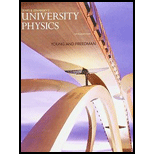
Concept explainers
Positive point charges q = +8.00 μC and q' = +3.00 μC are moving relative to an observer at point P, as shown in Fig. E28.6. The distance d is 0.120 m, ʋ = 4.50 × 106 m/s, and ʋ ' = 9.00 × 106m/s (a) When the two charges are at the locations shown in the figure, what are the magnitude and direction of the net magnetic field they produce at point P? (b) What are the magnitude and direction of the electric and magnetic forces that each charge exerts on the other, and what is the ratio of the magnitude of the electric force to the magnitude of the magnetic force? (c) If the direction of
Figure E28.6

Want to see the full answer?
Check out a sample textbook solution
Chapter 28 Solutions
University Physics (14th Edition)
Additional Science Textbook Solutions
Essential University Physics (3rd Edition)
Conceptual Integrated Science
Modern Physics
Physics (5th Edition)
College Physics: A Strategic Approach (3rd Edition)
Physics for Scientists and Engineers: A Strategic Approach, Vol. 1 (Chs 1-21) (4th Edition)
- An electron in a TV CRT moves with a speed of 6.0107 m/s, in a direction perpendicular to Earth's field, which has a strength of 5.0105 T. (a) What strength electric field must be applied perpendicular to the Earth’s field to make the election moves in a straight line? (b) If this is done between plates separated by 1.00 cm, what is the voltage applied? (Note that TVs are usually surrounded by a ferromagnetic material to shield against external magnetic fields and avoid the need for such a collection,)arrow_forwardThe velocity of a particle (m= 10 mg, q= -4 microC) at a t=0 is 20m/s in the positive x-direction. If the particle moves in a uniform electric field of 20 N/C in the positive x-direction, what is the particle's velocity (in m/s) at t = 11.9 s ?arrow_forwardAn electron (mass m=9.11×10−31kgm=9.11×10−31kg) is accelerated from the rest in the uniform field E⃗ E→ (E=1.45×104N/C)(E=1.45×104N/C) between two thin parallel charged plates. The separation of the plates is 1.10 cm. The electron is accelerated from rest near the negative plate and passes through a tiny hole in the positive plate. 1) With what speed does it leave the hole?arrow_forward
- An alpha particle with velocity v = (3 x 105,0,0) m/s enters a region where themagnetic field has a value B = (0,0,1.2) T. Determine the required magnitude and directionof an electric field E that will allow the alpha particle to continue to move along the x axis.arrow_forwardConsider two identical particles. The magnitude of their gravitational attraction is equal to the magnitude of their electrical repulsion. What is the ratio of q/m for these particles,given G=6.67×1.^-11Nm^2/kg^2 and Eo=8.854×10^-12C^2/N.m^2?arrow_forwardA particle of charge q and mass m moves in the uniform fields E⃗ =E0k^ and B⃗ =B0k^. At t = 0, the particle has velocity v⃗ 0=v0i^. What is the particle's speed at a later time t?arrow_forward
- A 8.20 μC charged 1.00 g cork ball is suspended vertically on a 1.100 m long light string in the presence of a uniform downward-directed electric field of magnitude E = 8.50x105 N/C. If the ball is displaced slightly from the vertical, it oscillates like a simple pendulum. (c) Determine the acceleration of the ball due to the combined effects of the gravitational and electric fields. That is, what is the effective acceleration due to both gravity and the electric field? (What is the new "g" that you should use in the period equation?)arrow_forwardThe electric field is zero everywhere except in the region 0≤x≤4.00 cm, where there is a uniform electric field of 110 N/C in the +y direction. A proton is moving in the +x direction with a speed of v = 1.00×10^6 m/s. When the proton passes through the region 0≤x≤4.00 cm, the electric field exerts a force on it. 1)When the x coordinate of the proton’s position is 4.00 cm, what is the x component of its velocity? (Express your answer to three significant figures.) 2)When the x coordinate of the proton’s position is 4.00 cm, what is the y component of its velocity?(Express your answer to three significant figures.) 3)When the x coordinate of its position equals 10.0 cm, what is the y component of its velocity? (Express your answer to three significant figures.)arrow_forwardA carbon-14 ion with a charge of +6.408x10^-19 C and a mass of 2.34x10^-26 kg is sent through a mass spectrometer and hits a detector at a point 10.0 cm to the left of where the beam leaves the velocity selector. The velocity selector and the detector are both in a region of magentic field of strength 0.500 T. What is the speed of the particle after it leaves the velocity selecctor? Then, what is the accelerating potential needed to reach the speed found in that part if the ions start from rest? Please also explain and show the steps you used to get there/the physics behind why/how you got to the answer to help me better understand. Thank you soo much. Also, the work and the explanation or most important because I already have the correct answer - I'm just unsure of how to get there.arrow_forward
- What charge is required to produce a repulsive force of 10 microNewtons on a charge q= 4.5 nanoC that is 5.0 m away?arrow_forwardA laser with a power output of 2.0 x 10-3 watts emits a visible light beam that illuminates a circular region of radius 1.0 mm on the screen. What is the magnitude of the electric field at the screen? a. 240 N/C b. 390 N/C c. 540 N/C d. 690 N/C e. 840 N/Carrow_forwardAn electron is to be accelerated in a uniform electric field having a strength of 2.3·106 Vm. a) What energy in keV is given to the electron if it is accelerated through 0.35 m? b) Over what distance (in km) would it have to be accelerated to increase its energy by 58 GeV?arrow_forward
